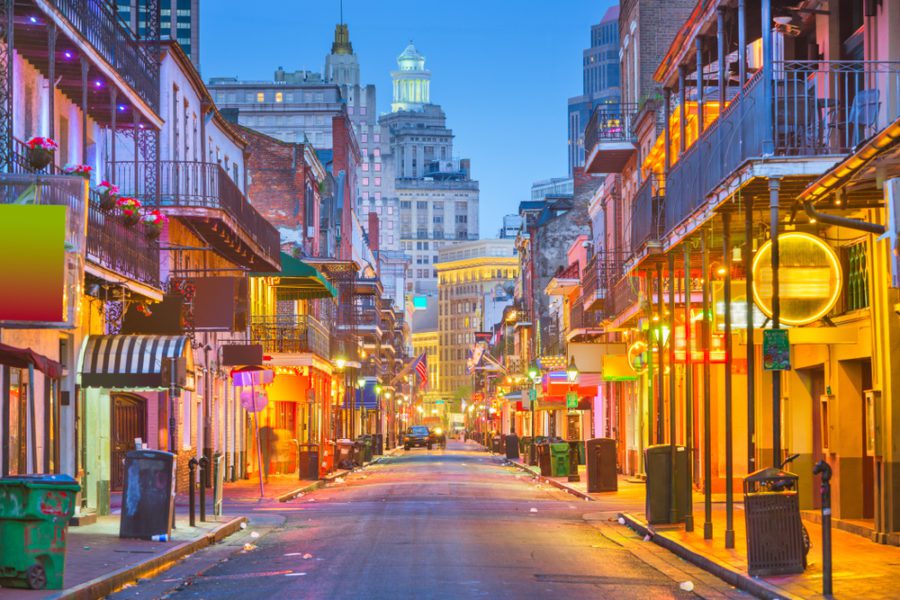New Orleans is one of the most unique and exciting cities in the United States, with a rich history, a bevy of curious local traditions, and of course, some of the best live music in the world. But if you’re thinking about moving there, you might wonder what it’s actually like to live in New Orleans.
So, is New Orleans a good place to live? Not only is it good—this city brings a versatile mix of vibrant culture, beautiful neighborhoods, and fun things to do. WIth this guide to the “Big Easy,” you’ll be ready to step into New Orleans living like a natural.
The Best Neighborhoods in New Orleans
The first step of moving to a new city is picking a neighborhood. But in a city as diverse as New Orleans, each part of town has a distinct vibe all its own. This guide to the best neighborhoods in New Orleans can help you decide which side of town will feel like home to you.
#1 Freret Corridor
In the 1920s and 1930s, Freret Street was one of New Orleans’ most bustling commercial zones, packed with shops, restaurants, and bars. But in the decades following World War II, large retailers strained local businesses and families who once lived in the area’s shotgun homes and raised cottages fled for other parts of town or the suburbs.1
Now, after years of decline, the Freret Corridor is experiencing a rebirth, thanks to a $300,000 investment from the city and a swarm of new businesses that are helping to restore Freret to its original glory.
Freret has always been a family-friendly neighborhood, but recent years have seen a convergence of singles and young couples who are drawn to the neighborhood for its central location and proximity to so many of New Orleans’ other great neighborhoods.
Not that you’d need to leave Freret to experience the best of what the New Orleans has to offer—far from it. Freret features:
- Shopping – The shops along Freret Street are some of the best you’ll find in New Orleans. Stretched along seven blocks you’ll discover everything from vintage stores to high-fashion boutiques, plus bike shops, an open-air market, and much, much more.2
- Cafes, restaurants, and bars – Whether you’re in the mood for a mid-morning latte, a delectable seafood lunch, or a rowdy night of cocktails and live music, you’ll find it all in Freret. This charming New Orleans neighborhood features dozens of coffee shops and cafes, a range of restaurants, and an exciting nightlife scene anchored by live music venue Gasa Gasa, located right in the heart of the neighborhood.1
- Architectural variety – The shotgun homes and cottages that are synonymous with New Orleans still abound in the Freret Corridor, but newer homes are starting to crop up as well.1 As this New Orleans neighborhood continues its revitalization, you should expect even more new homes, condos, and apartment buildings.
#2 Bywater
In a city full of one-of-a-kind neighborhoods, it can be hard to stand out. But over the past decade, the Bywater has managed to do just that. It’s now one of New Orleans’ most unique and eclectic neighborhoods.
Originally called Faubourg Washington, the Bywater has always been a refuge for New Orleans residents.3 These days, the Bywater retains that cultural mix and all-are-welcome attitude.
Just a few of the quirks and qualities that make the Bywater a great place to live are:
- Quaint restaurants
- Vibrant local artwork and murals
- Easy-going nightlife scene
#3 Central Business District
New Orleans’ Central Business District—or the CBD, as it’s fondly known—has always been an integral part of the city’s history.4 These days, it’s still the center of the city’s business industr, but is has a lot more to offer.
The CBD is also one of the city’s most sophisticated neighborhoods, full of restaurants run by award-winning chefs, high-end shopping, and a smattering of wine bars, art galleries, and bakeries.4 And football fans will be glad to know that the Mercedes Benz Superbowl is in the neighborhood.
Living in the CBD will likely mean condo or apartment living, so keep that in mind if you’re thinking of calling the area home. Condos can get a bit pricey, but the adjacent Warehouse District is a bit more affordable.
#4 Faubourg Marigny
Nestled between two of New Orleans’ most unique neighborhoods—the Bywater and the French Quarter—is one of its most interesting ones: Faubourg Marigny.
If you are an art lover, this neighborhood may be right for you. It’s home to a diverse array of artists, musicians, and other creative types, many of whom live in vibrantly colored homes that line the streets.5
Marigny is also home to Washington Square Park, one of the city’s historic landmarks. And along the famed Frenchmen Street are some of the city’s liveliest music venues. Plus, the neighborhood is teeming with unique and exciting establishments of all kinds, like:
- Cafes
- Coffee shops
- Restaurants
- Bars
When you add it all up, you get a neighborhood that’s perfect for anyone who lives their life slightly outside the box.
#5 Garden District
Few neighborhoods in New Orleans can match the Garden District for its southern charm that the city is known for. Once an enclave of the city’s wealthiest residents, it is still well-known for its elegant, historic mansions.6
The Garden District is considered one of the most walkable neighborhoods, but the famed streetcar runs right through it as well. But on foot, you’ll be able to visit the area’s world-class antique shops and clothing boutiques. And you might even bump into a celebrity resident or two.
#6 Gentilly
Gentilly Terrace is unlike most other neighborhoods in New Orleans for at least one reason: it’s above sea level.
But that isn’t all that sets this hilly zone apart from the rest of the town. A more residential area, it’s known for its architectural mix of California Craftsman homes nestled next to Spanish and Mediterranean revivals. Spacious lawns, towering oak trees, and driveways are other New Orleans rarities that abound in Gentilly.
Gentilly is a happening community with regular events like neighborhood socials, yard sales, and holiday celebrations, so if you’re interested in learning how to make friends as a travel nurse in a new city, this is the place for you.
Places to Explore in New Orleans
New Orleans is a historic town with modern, big-city amenities. And it’s that mix of down-home charm and metropolitan sophistication that makes it such a wonderful place to explore.
Living in New Orleans means you’re always just around the corner from some of the most recognizable places in the world, like:
- The French Quarter – Perhaps New Orleans most famous neighborhood, the French Quarter features dozens and dozens of restaurants, shops, and bars, plus a French Market and public gathering spaces.7
- Frenchman Street – This is the place to go for live New Orleans jazz. Bar after bar after bar blares jazz, rock, and other genres every night of the week.8
- Magazine Street – Magazine Street runs along the Mississippi from Audubon Park to Storyville.10 On the way, it’s filled with charming shops, eateries, and other attractions.
As a world-class city, you’ll never run out of things to do in New Orleans. The town’s world-renowned live music scene keeps things lively every night of the week, but there’s tons to do outside of bars and juke joints. The city offers an array of attractions, from swamp tours, cemetary tours, and house tours to a spectacular collection of art and history museums like the New Orleans Museum.
Delectable Restaurants to Try in New Orleans
New Orleans is notable for many reasons, but high atop the list is the city’s unparalleled food scene.10 From fresh seafood and classic New Orleans in gilded settings to places that combine delicious eats with live music, it’s impossible to go hungry in NOLA.
Some of the city’s dozens and dozens of stand-out restaurants are:
- Commander’s Palace, home of the 25-cent martini
- Bacchanal, a hip Bywater wine shop with charcuterie and live New Orleans jazz
- Brigsten’s, a staple of New Orleans fine dining
- Café Du Monde, a legendary French Quarter coffee shop
- Dooky Chase’s, a family-style restaurant with New Orleans staples
Tips for Moving to New Orleans
If reading this has helped you make up your mind about relocating to New Orleans, there are a few more things you should know before you rent a U-Haul. First, check out our general advice for moving to a new city for a few tips that will help make for a seamless move.
You’ll also have an easier time transitioning to New Orleans life if you keep the following factors in mind:
- Learn the lingo – New Orleans represents a blend of cultures from varied parts of the world, and you can see it just by looking at the street signs. You may encounter a lot of names that are difficult to pronounce, so do your research before you arrive.
- Ditch your compass – Thinking in terms of east, west, north, and south won’t get you terribly far in New Orleans’ somewhat complicated layout. The locals use the nearby bodies of water to navigate. Familiarize yourself with the locations of the Mississippi River, Lake Pontchartrain, and Lake Borgne.
- Get a bike – It’s good to have a car in New Orleans, but when you aren’t using it, getting around the city by bicycle can be very enjoyable.
It’s also a good idea to look into how to find housing as a travel nurse before you start planning.
Explore New Landscapes with Host Healthcare
Working as a travel nurse gives you the freedom to live anywhere while still fulfilling your dream of helping people look after their health. If you’re interested in combining your passion for healthcare with your lust for travel, apply to be a traveler and work with Host Healthcare.
With access to tens of thousands of healthcare positions all over the country, incredible benefits, and recruiters who care, Host Healthcare offers a premium travel healthcare experience. Find yourself with travel nursing and apply to Host Healthcare today.
Reviewed by:
Wendy Williams, BSN, RN, CCM
Nursing Specialty: Home Health/Long-Term Care, Pediatric Emergency, Case Management, Medically fragile special needs children and adults.
I started my career as a pediatric emergency room nurse and floated to the pediatric floor, PICU, burn unit, and NICU. I then transitioned and spent most of my career in home health and long-term care as a Nursing Director and Case Manager for medically fragile, special needs children and adults. I am a Certified Developmental Disabilities Nurse (CDDN) and Certified Case Manager (CCM).
Sources:
- “Freret.” Be New Orleans, beneworleans.com/neighborhoods/freret/ Accessed 5 Oct. 2022.
- Monteverde, Danny. “A Guide to Local Favorites on Freret Street.” Washington Post, 17 June 2019, www.washingtonpost.com/travel/united-states/freret-street-neighborhood-new-orleans/. Accessed 5 Oct. 2022.
- “Guide to the Bywater New Orleans.” Www.neworleans.com, 25 Apr. 2019, www.neworleans.com/blog/post/guide-to-the-bywater-neighborhood/. Accessed 5 Oct. 2022.
- “CBD, Warehouse District.” Be New Orleans, beneworleans.com/neighborhoods/cbd-warehouse-district/. Accessed 5 Oct. 2022.
- “Marigny.” Be New Orleans, beneworleans.com/neighborhoods/marigny/. Accessed 5 Oct. 2022.
- “Garden District.” BeNewOrleans, https://beneworleans.com/neighborhoods/garden-district/. Accessed 5 Oct. 2022.
- “French Quarter.” NewOrleans.com, https://www.neworleans.com/plan/neighborhoods/french-quarter/. Accessed 5 Oct. 2022.
- “Frenchman Street.” NewOrleans.com, https://www.neworleans.com/plan/streets/frenchmen-street/. Accessed 5 Oct. 2022.
- “Magazine Street.” MagazineStreet.com, https://magazinestreet.com/. Accessed 5 Oct. 2022.
- Lopez, Gerrish. “33 Best Restaurants in New Orleans.” Time Out, 15 September 2022, https://www.timeout.com/new-orleans/restaurants/best-restaurants-in-new-orleans. Accessed 5 Oct. 2022.











